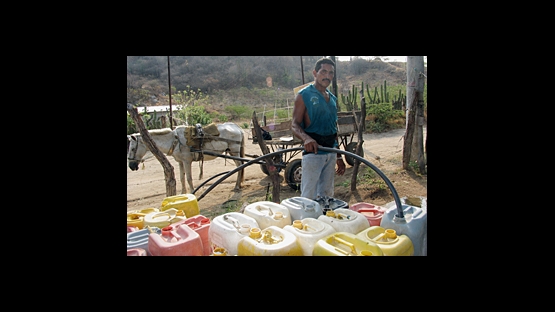A variety of pollutants can get into drinking water, from arsenic, to sewage, even petroleum. Polluted drinking water can devastate a country´s population and have far reaching effects on the health and education sectors and even the national economy.
The IAEA trains scientists in its Member States to use isotopes to track pollutants in water - finding out where contaminants enter the water supply, the speed at which they are moving and how the pollutants change (if at all) as the water moves underground or along the surface.
Pollutants in water come from three sources - agriculture, industry and human waste - or may be present naturally due to the geochemical nature of rocks; as is the case with arsenic.
Pollution from agriculture, industry and human waste each produce different kinds of pollutants. By studying the chemical composition of a pollutant, scientists can determine its origins.
Knowing Is Half the Battle
For example nitrate (NO3), which is made up of nitrogen and oxygen, is a common pollutant. Nitrogen has two isotopes - N-14 and N-15.
N-14 is lighter than N-15. The ratio of these two isotopes is different in human waste as opposed to fertilizers. Fertilizers use nitrogen from the air, whereas humans and animals have a biological process that changes nitrogen into different forms. So the isotope ratio of N-15 to N-14 present in nitrogen from fertilizer is very different from that which is present in other sources.
"By looking at this ratio, we can tell definitively if the groundwater is being polluted by the agricultural processes taking place in the vicinity or by poor sewage disposal," says Pradeep Aggarwal, Head of the IAEA´s Isotope Hydrology Section.
This knowledge is extremely useful to governments in their strategic planning.
Around the Globe
Isotope hydrology has been used with success in almost all countries of the world. The technique is not only used for nitrate, but for a wide range of pollutants including carbon, arsenic, lead, and other metals.
Take carbon from agriculture or petroleum as another example.
"C-13 is slightly heavier than C-12. And the ratio of C-13 to C-12 is slightly different in petroleum-related substances than in plants. So if you want to know if the carbon contaminating your water is from plant material (agriculture) or from petroleum, you can use isotope hydrology to do that," says Aggarwal.
Less than 1% of the world´s fresh water is readily accessible for human use, and supplies of quality freshwater are increasingly limited around the world. Therefore, isotope hydrology is becoming an even more valuable tool as potable water becomes more and more scarce.


